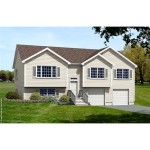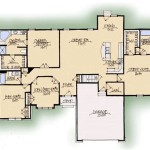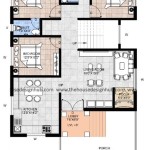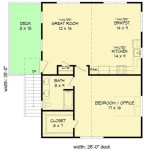Craftsman Home Plans: 2000 Square Feet of Timeless Appeal
The Craftsman style, born in the late 19th and early 20th centuries, continues to resonate with homeowners seeking a blend of simplicity, functionality, and artistic detail. Craftsman homes, often characterized by their low-pitched roofs, wide eaves, exposed rafters, and prominent porches, offer a timeless aesthetic that feels both comfortable and refined. When considering a Craftsman home plan in the 2000 square foot range, a balance between efficient space utilization and the style's inherent characteristics becomes paramount. This article will explore key considerations for designing and selecting Craftsman home plans within this square footage, highlighting the defining features, interior layout strategies, and exterior design elements that contribute to a successful and authentic Craftsman living experience.
The appeal of the Craftsman style lies in its honest expression of materials and construction. Rejecting the ornate Victorian era, the Craftsman movement emphasized hand-crafted elements and natural materials. This translates to the use of wood – both interior and exterior – stone accents, and earth-toned color palettes. A 2000 square foot Craftsman home plan requires careful planning to effectively incorporate these elements without feeling overwhelming or cramped. The design should prioritize open, flowing spaces that are both functional and visually appealing.
Key Features of Craftsman Architecture
Understanding the defining characteristics of Craftsman architecture is crucial when evaluating potential home plans. These features contribute significantly to the overall aesthetic and should be carefully considered throughout the design process.
One of the most recognizable features of a Craftsman home is its low-pitched roof, typically with wide, overhanging eaves. These eaves provide protection from the elements and create a distinctive shadow line, adding visual interest to the facade. Exposed rafters, often left unpainted or stained, further reinforce the emphasis on honest construction. Gables, dormers, and covered porches are also common elements, adding architectural detail and extending the living space outdoors.
Porches are integral to the Craftsman style, serving as a transition between the interior and exterior. They are often deep and welcoming, supported by substantial columns, frequently crafted from wood or stone. Porch railings, typically featuring simple, geometric designs, further enhance the Craftsman aesthetic. The porch becomes an extension of the living space, offering a place for relaxation and social interaction.
Exterior materials play a significant role in defining the Craftsman style. Wood siding, often in the form of horizontal clapboard or shingle, is a common choice. Stone accents, such as foundation walls, porch columns, or chimney surrounds, add visual texture and grounding to the design. Brick may also be incorporated, particularly in areas where durability and low maintenance are desired. The selection of exterior materials should be carefully considered to complement the overall architectural style and the surrounding landscape.
Windows in Craftsman homes are frequently multi-paned, often featuring a grid pattern in the upper sash. Double-hung windows are a common choice, allowing for efficient ventilation. Stained glass accents, particularly in entryways or above windows, can add a touch of artistic flair. Window placement and sizing should be carefully considered to maximize natural light and ventilation while maintaining privacy.
Interior Layout Considerations for 2000 Square Feet
Designing the interior of a 2000 square foot Craftsman home requires a strategic approach to space planning. Maximizing living space, creating a comfortable flow between rooms, and incorporating Craftsman-style detailing are paramount.
Open floor plans are often favored in contemporary Craftsman designs, particularly in the main living areas. Combining the living room, dining room, and kitchen into a single, unified space creates a sense of spaciousness and facilitates social interaction. However, it is important to define distinct zones within the open plan, using furniture placement, changes in flooring, or subtle architectural details to delineate different functions.
The kitchen is typically the heart of the home and should be designed for both functionality and aesthetics. Craftsman-style kitchens often feature natural wood cabinetry, such as oak or maple, with simple, clean lines. Granite or quartz countertops complement the natural materials, providing a durable and attractive work surface. A farmhouse sink and a tile backsplash add to the character of the space. Ample storage space is essential, and thoughtful organization can help to maximize the efficiency of the kitchen.
Bedrooms in a 2000 square foot Craftsman home should be designed for comfort and relaxation. Sufficient closet space is essential, and a well-designed master suite can include a walk-in closet and a private bathroom. Natural light is important in bedrooms, and window placement should be carefully considered to maximize sunlight while maintaining privacy. Incorporating Craftsman-style details, such as wood trim and paneled doors, can enhance the overall aesthetic.
Bathrooms should be designed for both functionality and style. Tile flooring and wainscoting are common features in Craftsman-style bathrooms. A clawfoot tub or a walk-in shower can add a touch of luxury. Natural light is important, and window placement should be carefully considered to maximize sunlight while maintaining privacy. Thoughtful storage solutions can help to keep the bathroom organized and clutter-free.
Craftsman homes often feature a fireplace as a focal point in the living room. The fireplace surround can be constructed from brick, stone, or wood, and should be designed to complement the overall architectural style. A mantle provides a place for displaying artwork or decorative objects. The fireplace serves as a gathering place and adds warmth and ambiance to the living space.
Incorporating Craftsman Details
Craftsman detailing is essential for achieving an authentic look and feel. These details, often subtle, contribute significantly to the overall character of the home.
Wood trim is a hallmark of the Craftsman style. Door and window casings, baseboards, and crown molding are typically made from natural wood, such as oak or maple, and are often stained to highlight the wood grain. The trim is typically simple and clean, with minimal ornamentation. The use of wood trim adds warmth and character to the interior spaces.
Paneled doors are another common Craftsman detail. These doors typically feature a series of recessed panels, often arranged in a simple, geometric pattern. The doors are typically made from natural wood and are stained to highlight the wood grain. Paneled doors add texture and visual interest to the interior spaces.
Built-in cabinetry is a functional and stylish feature that is often found in Craftsman homes. Built-in bookcases, china cabinets, and window seats can add storage space and architectural detail to the rooms. The cabinetry is typically made from natural wood and is designed to complement the overall architectural style.
Lighting fixtures in Craftsman homes typically feature simple, geometric designs. Metal finishes, such as bronze or copper, are often used. The lighting fixtures should be designed to complement the overall architectural style and to provide adequate illumination for the space. Pendant lights, sconces, and table lamps are all common choices.
Color palettes in Craftsman homes typically feature earth tones, such as browns, greens, and grays. These colors are inspired by nature and create a sense of warmth and tranquility. Accent colors, such as reds, yellows, and blues, can be used to add pops of color and visual interest. The color palette should be carefully considered to create a cohesive and harmonious look throughout the home.
Selecting a Craftsman home plan in the 2000 square foot range requires a careful consideration of both the style's inherent characteristics and the functional needs of the homeowner. By prioritizing open floor plans, incorporating natural materials, and paying attention to detail, a design can achieve a timeless and comfortable living space that embodies the enduring appeal of the Craftsman style.

2 000 Sq Ft House Plans Houseplans Blog Com

Craftsman Home With 4 Bedrms 2000 Sq Ft House Plan 109 1051 Tpc

Craftsman Home With 4 Bedrms 2000 Sq Ft House Plan 109 1053 Tpc

One Story 3 Bed Craftsman Home Plan Just Under 2 000 Square Feet 62350dj Architectural Designs House Plans

Craftsman Style House Plan 3 Beds 2 Baths 2000 Sq Ft 48 241 Plans One Story Floor

2000 Sf House Floor Plans Modern Home Design Blueprints Drawings New One Story Best

2000 Square Feet House Plans By Max Fulbright Designs

Craftsman Style House Plan 3 Beds 2 Baths 1509 Sq Ft 21 246 Houseplans Com

Craftsman House Plan With 2000 Square Feet And 4 Bedrooms From Dream Home Source Plans Style

House Plan 59148 Craftsman Style With 1800 Sq Ft 3 Bed 2 Bath








